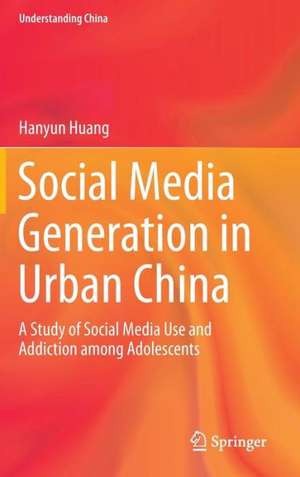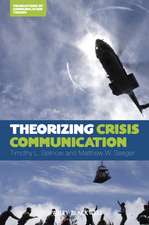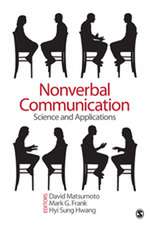Social Media Generation in Urban China: A Study of Social Media Use and Addiction among Adolescents: Understanding China
Autor Hanyun Huangen Limba Engleză Hardback – 29 ian 2014
This study employed quantitative questionnaire surveys among adolescents as the main research method, supplemented by qualitative pre-survey focus groups among adolescents and post-survey in-depth interviews among parents and teachers. Questionnaire surveys were conducted based on a multi-stage cluster sampling of seven middle schools in five urban Chinese cities: Beijing, Shanghai, Guangzhou, Shenzhen and Xiamen. The final sample consisted of 1,549 adolescents, of whom 90% had used social media. Using Young’s classic definition of Internet addiction, 15.6% of participants were classified as social media addicts. The addicted adolescents were often self-absorbed, bored with their leisure time, and good at using manipulation through social media for impression management. Addicts experienced four major social media addiction symptoms: preoccupation, adverse consequences, alleviation of negative emotions and loss of interest in social activities.
The seven social media gratifications identified in this study can be categorized into social, information and entertainment gratifications. Among these, entertainment gratifications had the most power to predict social media addiction, while information gratifications were the least likely to lead to addiction. Furthermore, these gratifications were found to be powerful mediators between the adolescents’ sociopsychological traits and social media addiction. Finally, the results also indicated that social media addiction and its symptoms had a significant negative impact on adolescents’ academic performance and social capital.
| Toate formatele și edițiile | Preț | Express |
|---|---|---|
| Paperback (1) | 380.63 lei 6-8 săpt. | |
| Springer Berlin, Heidelberg – 27 aug 2016 | 380.63 lei 6-8 săpt. | |
| Hardback (1) | 387.75 lei 6-8 săpt. | |
| Springer Berlin, Heidelberg – 29 ian 2014 | 387.75 lei 6-8 săpt. |
Din seria Understanding China
- 18%
 Preț: 734.27 lei
Preț: 734.27 lei - 18%
 Preț: 732.07 lei
Preț: 732.07 lei - 18%
 Preț: 886.92 lei
Preț: 886.92 lei - 15%
 Preț: 694.69 lei
Preț: 694.69 lei - 15%
 Preț: 636.63 lei
Preț: 636.63 lei - 15%
 Preț: 703.85 lei
Preț: 703.85 lei - 18%
 Preț: 887.55 lei
Preț: 887.55 lei - 15%
 Preț: 646.30 lei
Preț: 646.30 lei - 18%
 Preț: 897.02 lei
Preț: 897.02 lei -
 Preț: 389.70 lei
Preț: 389.70 lei - 18%
 Preț: 952.40 lei
Preț: 952.40 lei - 18%
 Preț: 954.45 lei
Preț: 954.45 lei - 18%
 Preț: 787.91 lei
Preț: 787.91 lei - 15%
 Preț: 694.55 lei
Preț: 694.55 lei - 15%
 Preț: 637.13 lei
Preț: 637.13 lei - 18%
 Preț: 898.13 lei
Preț: 898.13 lei - 18%
 Preț: 738.06 lei
Preț: 738.06 lei - 18%
 Preț: 781.00 lei
Preț: 781.00 lei -
 Preț: 394.51 lei
Preț: 394.51 lei - 15%
 Preț: 650.69 lei
Preț: 650.69 lei - 18%
 Preț: 794.07 lei
Preț: 794.07 lei - 15%
 Preț: 644.49 lei
Preț: 644.49 lei - 15%
 Preț: 646.75 lei
Preț: 646.75 lei - 18%
 Preț: 946.10 lei
Preț: 946.10 lei - 18%
 Preț: 797.41 lei
Preț: 797.41 lei - 18%
 Preț: 1217.27 lei
Preț: 1217.27 lei - 15%
 Preț: 642.03 lei
Preț: 642.03 lei - 15%
 Preț: 641.85 lei
Preț: 641.85 lei - 18%
 Preț: 1249.63 lei
Preț: 1249.63 lei - 15%
 Preț: 642.83 lei
Preț: 642.83 lei -
 Preț: 388.52 lei
Preț: 388.52 lei
Preț: 387.75 lei
Nou
Puncte Express: 582
Preț estimativ în valută:
74.20€ • 77.31$ • 61.43£
74.20€ • 77.31$ • 61.43£
Carte tipărită la comandă
Livrare economică 03-17 aprilie
Preluare comenzi: 021 569.72.76
Specificații
ISBN-13: 9783642454400
ISBN-10: 3642454402
Pagini: 161
Ilustrații: XVIII, 143 p. 5 illus.
Dimensiuni: 155 x 235 x 17 mm
Greutate: 0.41 kg
Ediția:2014
Editura: Springer Berlin, Heidelberg
Colecția Springer
Seria Understanding China
Locul publicării:Berlin, Heidelberg, Germany
ISBN-10: 3642454402
Pagini: 161
Ilustrații: XVIII, 143 p. 5 illus.
Dimensiuni: 155 x 235 x 17 mm
Greutate: 0.41 kg
Ediția:2014
Editura: Springer Berlin, Heidelberg
Colecția Springer
Seria Understanding China
Locul publicării:Berlin, Heidelberg, Germany
Public țintă
ResearchCuprins
Introduction.- Literature Review.- Research Methods.- Uses, Gratifications, and Addiction of Social Media.- Social Media Addiction and Sociopsychological Traits.- Social Media Addiction, Academic Performance, and Social Capital.- Beyond the Survey: What Parents and Teachers Said.- Discussion and Conclusions.- References.
Recenzii
“In her 2014 book Social Media Generation in Urban China - a Study of Social Media Use and Addiction among Adolescents, Dr Hanyun Huang introduces the concept of “social media addiction” and paints a vivid portrait of those young Internet users in China who are afflicted by this rising social problem. … Huang’s book provides a wealth of knowledge and high-quality data for scholars, educators, and policymakers to gain insights about problematic social media use.” (Mike Z. Yao, Chinese Journal of Communication, Vol. 9 (3), July, 2016)
Textul de pe ultima copertă
Social media such as instant messaging (IM), social networking sites (SNS), blogs, and microblogs are an integral part of adolescents’ lives in China. Anecdotal evidence reported in the news has suggested that the increasing popularity of social media could make adolescents more vulnerable to being addicted. This exploratory study proposes the concept of “social media addiction” and examines (a) whether social media addiction exists among adolescents in urban China and, if so, who the addicts are, what their symptoms are, and to what extent they are addicted; (b) whether sociopsychological traits (e.g., need for affiliation, impression management, narcissism, and leisure boredom) can predict social media addiction among adolescents; (c) what gratifications are obtained by adolescents from their use of social media and whether these gratifications can predict social media addiction; and (d) to what degree social media addiction influences adolescents’ academic performance and socialcapital.
This study employed quantitative questionnaire surveys among adolescents as the main research method, supplemented by qualitative pre-survey focus groups among adolescents and post-survey in-depth interviews among parents and teachers. Questionnaire surveys were conducted based on a multi-stage cluster sampling of seven middle schools in five urban Chinese cities: Beijing, Shanghai, Guangzhou, Shenzhen and Xiamen. The final sample consisted of 1,549 adolescents, of whom 90% had used social media. Using Young’s classic definition of Internet addiction, 15.6% of participants were classified as social media addicts. The addicted adolescents were often self-absorbed, bored with their leisure time, and good at using manipulation through social media for impression management. Addicts experienced four major social media addiction symptoms: preoccupation, adverse consequences, alleviation of negative emotions, and loss of interest in social activities.
The seven socialmedia gratifications identified in this study can be categorized into social, information, and entertainment gratifications. Among these, entertainment gratifications had the most power to predict social media addiction, while information gratifications were the least likely to lead to addiction. Furthermore, these gratifications were found to be powerful mediators between the adolescents’ sociopsychological traits and social media addiction. Finally, the results also indicated that social media addiction and its symptoms had a significant negative impact on adolescents’ academic performance and social capital.
This study employed quantitative questionnaire surveys among adolescents as the main research method, supplemented by qualitative pre-survey focus groups among adolescents and post-survey in-depth interviews among parents and teachers. Questionnaire surveys were conducted based on a multi-stage cluster sampling of seven middle schools in five urban Chinese cities: Beijing, Shanghai, Guangzhou, Shenzhen and Xiamen. The final sample consisted of 1,549 adolescents, of whom 90% had used social media. Using Young’s classic definition of Internet addiction, 15.6% of participants were classified as social media addicts. The addicted adolescents were often self-absorbed, bored with their leisure time, and good at using manipulation through social media for impression management. Addicts experienced four major social media addiction symptoms: preoccupation, adverse consequences, alleviation of negative emotions, and loss of interest in social activities.
The seven socialmedia gratifications identified in this study can be categorized into social, information, and entertainment gratifications. Among these, entertainment gratifications had the most power to predict social media addiction, while information gratifications were the least likely to lead to addiction. Furthermore, these gratifications were found to be powerful mediators between the adolescents’ sociopsychological traits and social media addiction. Finally, the results also indicated that social media addiction and its symptoms had a significant negative impact on adolescents’ academic performance and social capital.
Caracteristici
First book analyzing social media addiction among adolescents in China Valuable first-hand empirical data from adolescents in five major cities in China Analyzes in detail the social media addiction symptoms of adolescents Provides effective guidelines for parents and educators to detect at an early stage and possibly prevent social media addiction in adolescents Sets up a comprehensive model of social media addiction among adolescents from the causes to the consequences Includes supplementary material: sn.pub/extras














